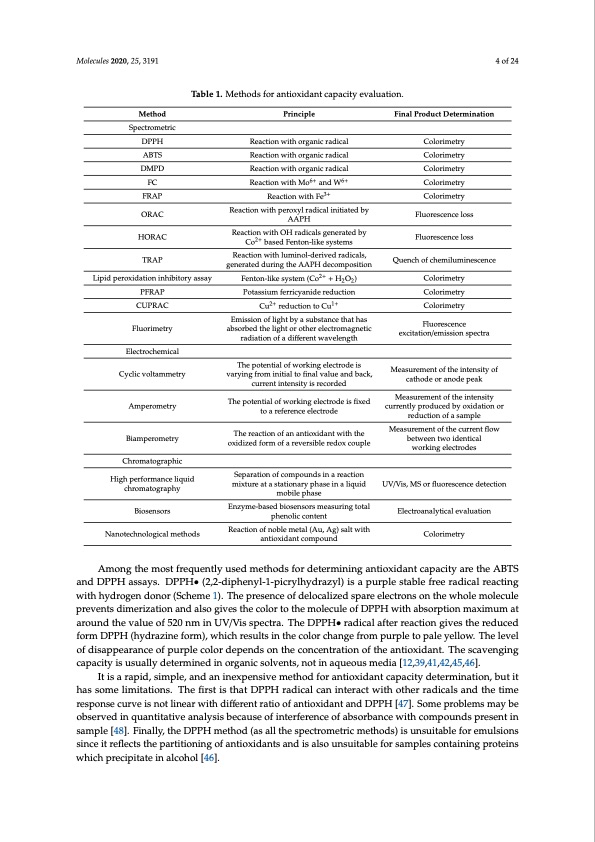
PDF Publication Title:
Text from PDF Page: 004
Molecules 2020, 25, 3191 4 of 24 Method Spectrometric DPPH ABTS DMPD FC FRAP ORAC HORAC TRAP Lipid peroxidation inhibitory assay PFRAP CUPRAC Fluorimetry Electrochemical Cyclic voltammetry Amperometry Biamperometry Chromatographic High performance liquid chromatography Biosensors Nanotechnological methods Principle Reaction with organic radical Reaction with organic radical Reaction with organic radical Reaction with Mo6+ and W6+ Reaction with Fe3+ Reaction with peroxyl radical initiated by AAPH Reaction with OH radicals generated by Co2+ based Fenton-like systems Reaction with luminol-derived radicals, generated during the AAPH decomposition Fenton-like system (Co2+ + H2O2) Potassium ferricyanide reduction Cu2+ reduction to Cu1+ Emission of light by a substance that has absorbed the light or other electromagnetic radiation of a different wavelength The potential of working electrode is varying from initial to final value and back, current intensity is recorded The potential of working electrode is fixed to a reference electrode The reaction of an antioxidant with the oxidized form of a reversible redox couple Separation of compounds in a reaction mixture at a stationary phase in a liquid mobile phase Enzyme-based biosensors measuring total phenolic content Reaction of noble metal (Au, Ag) salt with antioxidant compound Final Product Determination Colorimetry Colorimetry Colorimetry Colorimetry Colorimetry Fluorescence loss Fluorescence loss Quench of chemiluminescence Colorimetry Colorimetry Colorimetry Fluorescence excitation/emission spectra Measurement of the intensity of cathode or anode peak Measurement of the intensity currently produced by oxidation or reduction of a sample Measurement of the current flow between two identical working electrodes UV/Vis, MS or fluorescence detection Electroanalytical evaluation Colorimetry Table 1. Methods for antioxidant capacity evaluation. Among the most frequently used methods for determining antioxidant capacity are the ABTS and DPPH assays. DPPH• (2,2-diphenyl-1-picrylhydrazyl) is a purple stable free radical reacting with hydrogen donor (Scheme 1). The presence of delocalized spare electrons on the whole molecule prevents dimerization and also gives the color to the molecule of DPPH with absorption maximum at around the value of 520 nm in UV/Vis spectra. The DPPH• radical after reaction gives the reduced form DPPH (hydrazine form), which results in the color change from purple to pale yellow. The level of disappearance of purple color depends on the concentration of the antioxidant. The scavenging capacity is usually determined in organic solvents, not in aqueous media [12,39,41,42,45,46]. It is a rapid, simple, and an inexpensive method for antioxidant capacity determination, but it has some limitations. The first is that DPPH radical can interact with other radicals and the time response curve is not linear with different ratio of antioxidant and DPPH [47]. Some problems may be observed in quantitative analysis because of interference of absorbance with compounds present in sample [48]. Finally, the DPPH method (as all the spectrometric methods) is unsuitable for emulsions since it reflects the partitioning of antioxidants and is also unsuitable for samples containing proteins which precipitate in alcohol [46].PDF Image | Antioxidant Activity Determination of Silver Nanoparticles

PDF Search Title:
Antioxidant Activity Determination of Silver NanoparticlesOriginal File Name Searched:
molecules-25-03191.pdfDIY PDF Search: Google It | Yahoo | Bing
Turbine and System Plans CAD CAM: Special for this month, any plans are $10,000 for complete Cad/Cam blueprints. License is for one build. Try before you buy a production license. More Info
Waste Heat Power Technology: Organic Rankine Cycle uses waste heat to make electricity, shaft horsepower and cooling. More Info
All Turbine and System Products: Infinity Turbine ORD systems, turbine generator sets, build plans and more to use your waste heat from 30C to 100C. More Info
CO2 Phase Change Demonstrator: CO2 goes supercritical at 30 C. This is a experimental platform which you can use to demonstrate phase change with low heat. Includes integration area for small CO2 turbine, static generator, and more. This can also be used for a GTL Gas to Liquids experimental platform. More Info
Introducing the Infinity Turbine Products Infinity Turbine develops and builds systems for making power from waste heat. It also is working on innovative strategies for storing, making, and deploying energy. More Info
Need Strategy? Use our Consulting and analyst services Infinity Turbine LLC is pleased to announce its consulting and analyst services. We have worked in the renewable energy industry as a researcher, developing sales and markets, along with may inventions and innovations. More Info
Made in USA with Global Energy Millennial Web Engine These pages were made with the Global Energy Web PDF Engine using Filemaker (Claris) software.
Infinity Turbine Developing Spinning Disc Reactor SDR or Spinning Disc Reactors reduce processing time for liquid production of Silver Nanoparticles.
| CONTACT TEL: 608-238-6001 Email: greg@infinityturbine.com | RSS | AMP |